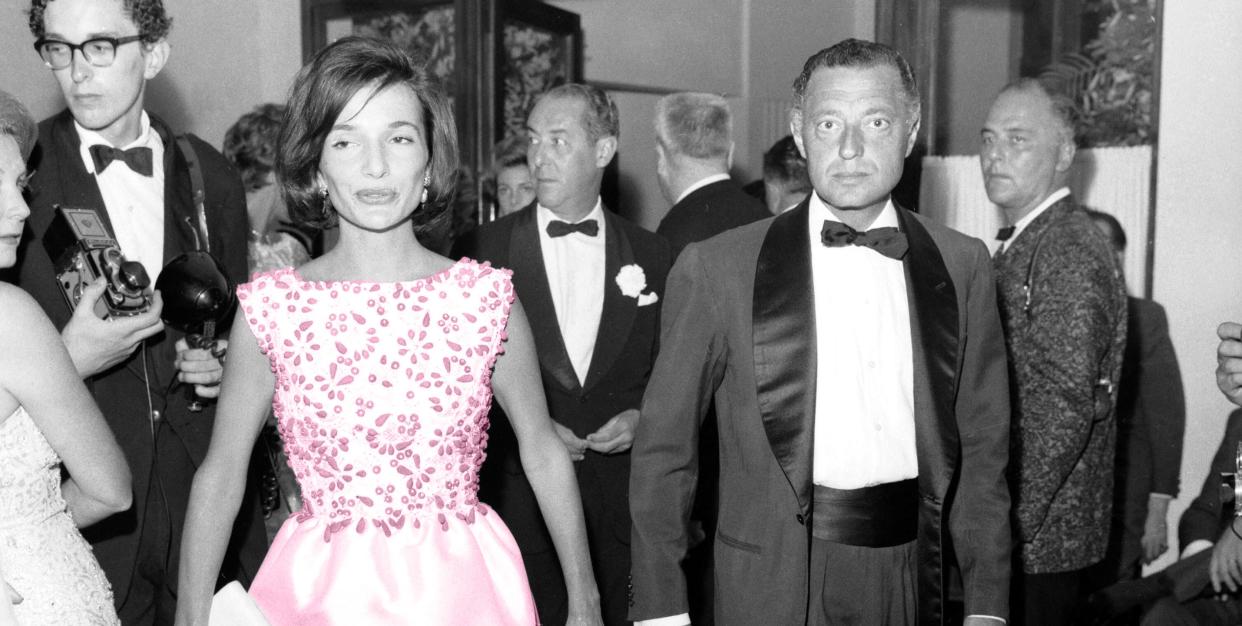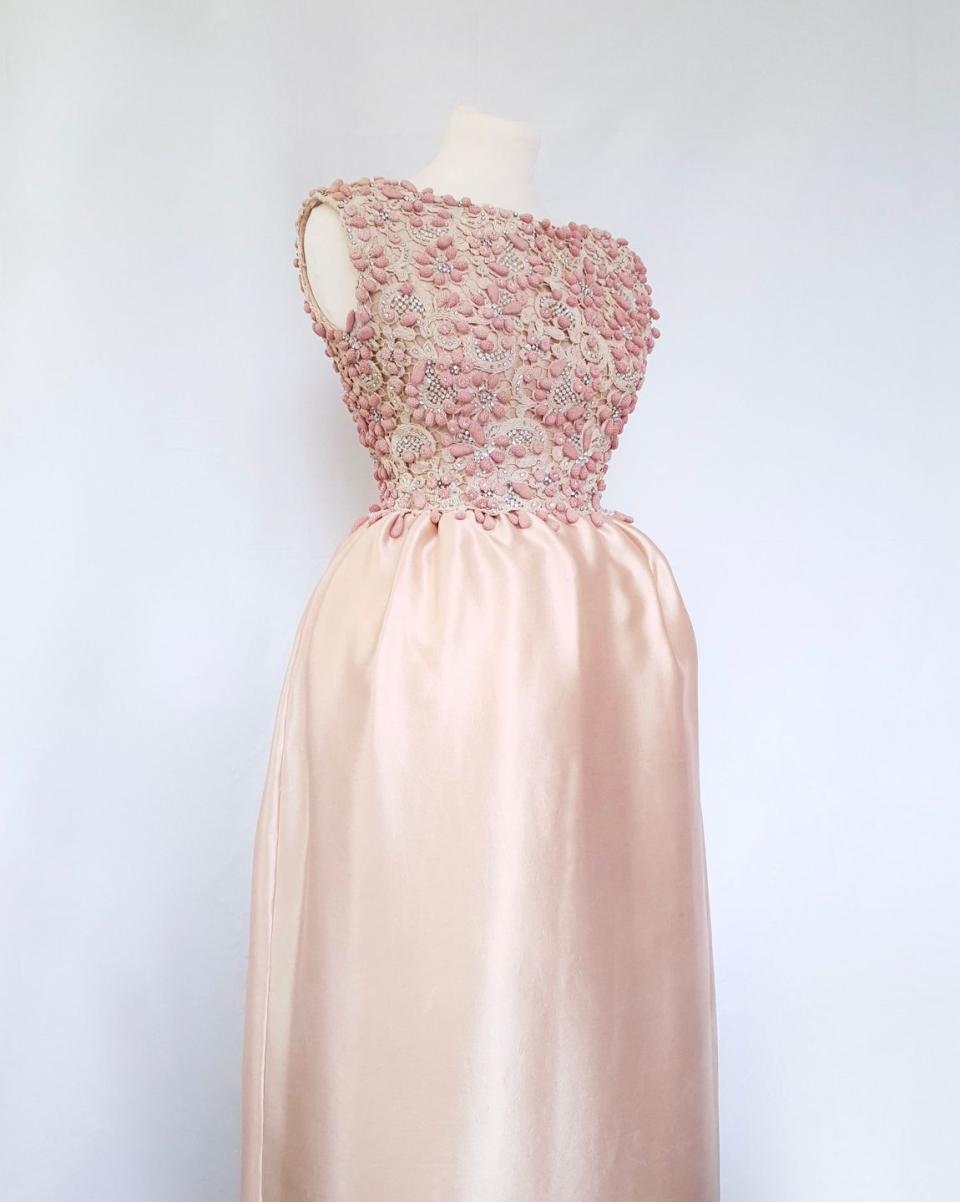Unraveling The Mystery of Lee Radziwill's Missing Givenchy Gown

Decades before Lee Radziwill passed away in 2019, she unwittingly laid the pattern for a fascinating fashion mystery—one with all the hallmarks of an Agatha Christie novel.
It begins in 1961, in a glamorous Paris atelier, and involves the American-born princess, a torn dress, a soured relationship, political alliances, European royalty, and even a detective of sorts.
The story starts to unfold almost 60 years later when, last March, London-based costume designer Henry Wilkinson—our detective—stumbled across the remnants of what was clearly a haute couture Givenchy evening dress consisting of an elaborate Lesage-embroidered bodice with just a few inches of severed skirt still attached. “I immediately recognized it was from the 1960s,” recalls Wilkinson. “And I could see from the photos it was in very bad condition.”
But the 2019 graduate of London’s Royal Central School of Speech and Drama was up for the challenge of researching and restoring the once glorious gown. As it turns out, the 23-year-old is also a collector of early Givenchy haute couture and an unassuming expert on the designer’s work. Wilkinson negotiated the price and secured the tattered bodice for £200 (about $256) from a seller who acquired it from a London theater company where it had been languishing in the costume department. “It was definitely a lot of money for something falling apart,” he says.
The acquisition led him back to the Givenchy archive in Paris ,where he worked for several months as a research intern while completing his studies. But there he hit a dead end. Although Givenchy was able to confirm the piece was made specially for an important client, the archive had no records related to the dress or its former owner. “Hubert never formally established an archive of his own work during his career,” says Wilkinson. “Thankfully, most collection photographs are preserved, but it’s not always the case for rarer records of exclusive designs such as this one—particularly those dating back to the 1950s and '60s.”

Wilkinson surmised it would cost about $500 to restore the dress and, though not a huge amount of money, he needed help. Happily, he found a patron in Toronto-based vintage dealer Cherie Balch, owner of Shrimpton Couture. “We’d been acquainted for some time and he bought a few pieces from me,” says Balch, who counts Rihanna and Tracee Ellis Ross among her clients. So, when Wilkinson reluctantly posted a request for financial help on Instagram, Balch decided to sponsor the entire project. “When I see someone so young and passionate, I want to support them if I can,” she says. “Restoration work isn’t often acknowledged in the vintage world, and Henry was approaching the project in a very scholarly way.”
The project wasn't always simple. “Internally there was a lot of damage and the original zipper had been ripped out and replaced,” Wilkinson recalls. “The amazing thing was that the embroidery and beading was in excellent condition.” The most difficult part of the restoration was finding the right fabric for the skirt. After doing research on similar Givenchy gowns he discovered it was silk zibeline, a fabric the designer used for several dresses for Jackie Kennedy. He sourced the zibeline and reached out to a friend at Atelier Nine, a textile conservancy in London, who helped dye the fabric to match the original shade of rose gold. For the rest of the finishing work, he relied on the other period Givenchy dresses in his collection. “I was trained in construction, but in terms of proper couture finishing, that’s not something I was taught—so there was no better way to learn than by studying other original pieces.”

Then, in late January of this year, several weeks before completing the restoration, he received a message through Instagram with a mind-blowing surprise—one of his followers found a photo of Lee Radziwill wearing the dress. Further research turned up evidence that she wore the stunning gown on three memorable occasions in 1961: first to accompany her sister and JFK to a reception in Paris hosted by French President Charles de Gaulle at the Élysée Palace on May 31; then again on June 5 for the highly publicized visit by the Kennedys to Buckingham Palace (an event dramatized in The Crown); and finally, to the Red Cross Gala in Monte Carlo that August with Princess Grace, Prince Rainier, and Marella and Gianni Agnelli in attendance.
With confirmation from the Givenchy archive that the dress was a one-of-a-kind piece and now the photo documentation, there was just one question begging to be answered—how did this incredible couture dress belonging to one of the most stylish women of the 20th century end up coming apart at the seams in a London theater’s wardrobe closet?
It’s true that Givenchy and Radziwill had something of a falling-out in 1962 when Lee was covering the Paris collections for McCall’s magazine. The designer had a standing rule that press couldn’t preview the collections before clients and, technically, Radziwill was now press. Incensed, she reportedly never forgave that Givenchy wouldn’t make an exception for her. After all, she’d been an important client for several years—even serving as Jackie’s fit model and then smuggling the Givenchy gowns from Paris to Washington D.C. so nobody would know the First Lady was buying French couture. “Part of me likes to imagine that Lee was so angry she reached for the shears and cut the skirt off herself,” Wilkinson says with a laugh.
Here’s where the couture conundrum begins to unravel. While it’s possible the pair parted ways over the incident, it’s unlikely the princess shredded the gown before tossing it out in a fit of anger. There’s actually a more plausible scenario to explain its unusual disposition. “Lee was addicted to the theater,” says her close friend, designer Ralph Rucci. “It could have been as simple as someone from that theater commenting on the embroidery of the bodice and asking if they could study it, and she just gave it to them.” As for how the skirt became so dramatically separated from the bodice, Rucci maintains the important part of the dress is the bodice, not the skirt. “As a costume for the theater all the drama is in the embroidered top—the silk skirt would have been insignificant.”

“I don’t know how this particular dress ended up where it did, but in the absence of a friendship [with Givenchy] I’m sure she just handed it off to someone who could make some use of it,” agrees close friend Hamilton South. “She rarely wore a designer’s clothes—let alone kept them over time—unless there was some friendship involved.”
“Lee was the type of woman who had no emotional relationship with clothes,” adds Rucci. “The most important thing to know is that she was a trendsetter—she wore the clothes, she used them, then she graduated from them.” He also notes that it’s unlikely she worn any couture gown more than three or four times.

“While Lee had a deep appreciation and understanding of the importance of history, she viewed clothes—and fashion in general—as something momentary and immediate,” explains South. In fact, Radziwill rarely donated her clothes to museums. Apart from the Shön gown worn to Truman Capote’s Black and White Ball in 1966—which she gave to London’s Victoria & Albert Museum in 1974—and a handful of pieces including Saint Laurent, Shön, and Courrèges given to The Met in 1977, there are no other notable donations on record.
The absence of such bequests on her part, unlike those of other society doyennes, leads to speculation about what became of her early Givenchy. In October 2019, Christie’s offered the “Collection of Lee Radziwill” bringing in $1.26 million for an array of home furnishings, artwork, memorabilia, and a paltry selection of designer accessories—but not one item of clothing appeared among the nearly 170 lots. At the time, the auction house couldn’t comment on the Radziwill estate’s plan for her wardrobe and there’s been no discussion on the topic since. If the speculation by Lee’s intimates is to be believed, it’s likely—in a not-so-surprising plot twist—she shed her couture cladding a long time ago, paying little deference to what curators and collectors would think today.
You Might Also Like


